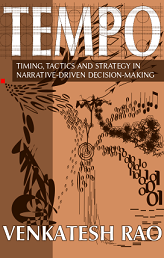I learned about elder games from the classic Steve Yegge post, The Borderlands Gun Collectors Club (ht Chris Reid). The idea is that in a complex game, after most players have finished a first full play-through, the mechanics might still leave interesting things for them to do. An Act 2 game-within-a-game emerges for experienced players who have exhausted the nominal game. A game dominated by such second-order players is an elder game. In Borderlands, the elder game was apparently gun collecting.
An elder game tends to be more open-ended than the nominal game. In the ideal case, it is a mature infinite game that can go on indefinitely.

Blogging is now an elder game. After a decade of pursuing virality (out of the corner of my eye — direct pursuit is a recipe for burnout by pandering), the inside of my head now looks like the picture above. A vast mess of unsystematically explored territory, with flags planted on a few legible patches. That’s what organic virality is, epistemologically: a communicable patch of legibility in an ungoverned thought space of interest to many.
An elder game can be contrasted with a late style, which is a style of creative production taken to an extreme, past the point of baroque exhaustion, in a sort of virtuoso display of raging against the dying of the night. Late-style game play is an overclocked finite game resisting the forces of mortality. An elder game is a derivative infinite game, emergent immortality hacked out of mortality.
Old blogs must choose: should they turn into elder blogs, or should they turn into late-style blogs? One does not preclude the other, but you must decide what you solve for.
I don’t grok the ribbonfarm elder game yet, but I do know it’s time to ask: what comes after virality?





